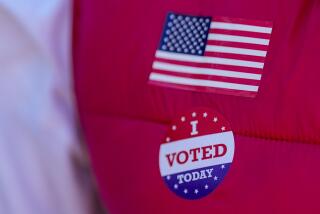Campaign 2012 may be negative, but it’s turning voters on
- Share via
Voter enthusiasm about the 2012 election appears to be on the rise, particularly in heavily contested swing states, rebutting the often-repeated idea that negative campaigning reduces turnout.
The fear that negativity in campaigns will turn off voters comes up frequently. It’s easy to find voters who complain about incessant political ads on their televisions, robo calls on their telephones and messages in their emails, and those voters often decry the sharply negative tone of what they are hearing.
But despite the unhappiness with the tone of campaigns, the evidence strongly suggests that a hotly contested race – even a negative one – makes people more likely to vote, not less.
A rise in enthusiasm and engagement has shown up in several polls recently. The Pew Research Center, for example, found that 70% of registered voters now say they have given a lot of thought to the election, up a few points from the level the survey found in June. The level of engagement hasn’t hit the heights reached in 2008, largely because fewer young voters say they have paid a lot of attention. But this year’s figure significantly exceeds the level of voter engagement in 1996 and 2000 and is on par with the very closely contested 2004 election.
Democrats, in particular, have become more engaged during the course of the summer, the Pew study found. In June, Republicans were significantly more likely than Democrats to say they were paying a lot of attention to the race. Now the two parties’ supporters are about evenly matched.
Confirming data coming from the Gallup poll, which asks voters a slightly different question, how enthusiastic they are about voting. Gallup finds that voters in swing states – the ones most exposed to all those negative ads – are slightly more enthusiastic than voters in less contested states.
In Gallup’s latest compilation, 59% of registered voters in the 12 states that Gallup considers battlegrounds said they were either “extremely” or “very” enthusiastic about voting this year. Nationwide, that figure was 55%, and it was slightly lower in the non-battleground states, where voters have been less exposed to all that negativity.
As with Pew, the Gallup figures showed a significant increase in voter engagement since earlier in the summer, when 46% of voters reported high levels of enthusiasm.
As the contest has become more intense, enthusiasm has increased among Democrats, Republicans and independents, Gallup found. The biggest increase, however, has come on the Democratic side. In June, Democrats were slightly less likely than Republicans to say they were highly enthusiastic. Now, by contrast, Democrats are significantly more likely to say they are “very” or “extremely” enthusiastic – nine percentage points more likely in the battleground states.
Follow Politics Now on Twitter and Facebook
Twitter: @DavidLauter
More to Read
Get the L.A. Times Politics newsletter
Deeply reported insights into legislation, politics and policy from Sacramento, Washington and beyond. In your inbox twice per week.
You may occasionally receive promotional content from the Los Angeles Times.











